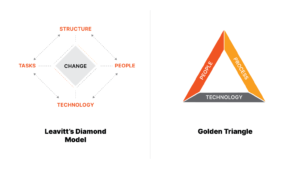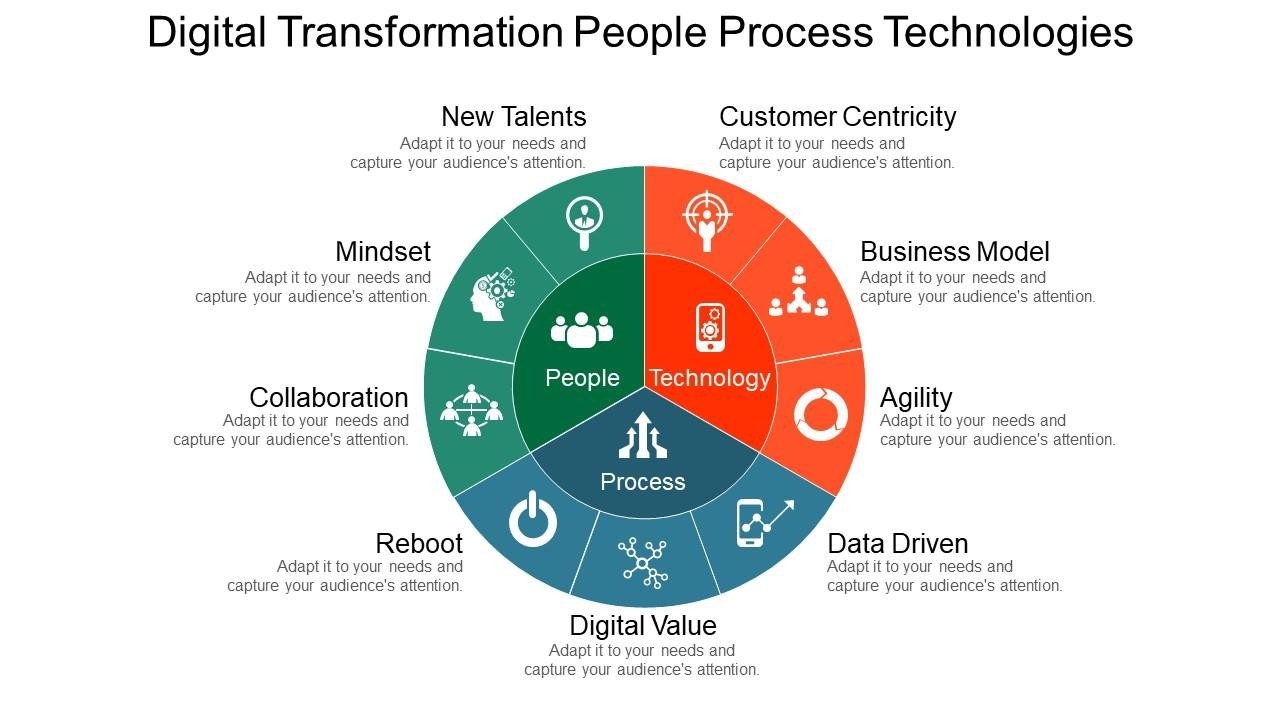16 OCTOBER | 5 MIN READ
People, Process, Technology: How ‘The Golden Triangle’ Drives Digital Transformation
In the ever-evolving landscape of business and industry, achieving excellence isn’t just a matter of having the latest technology or the most streamlined processes. It’s about the harmonious interplay of three crucial elements: People, Process, and Technology.
BLOG POST
Understanding the Different Model-Based Approaches: MBSE, MBD, and MBE
Read More →
BLOG POST
Next generation Digital Thread: The Model-Based Enterprise Part 1...
Read More →
This trio, often referred to as the Golden Triangle, forms the foundation upon which successful organisations are built. In this series, we will demystify the Golden Triangle, starting with an introduction to the People, Process, Technology (or PPT) Framework.
People, Process, Technology: A Brief History
In 1964, Dr. Harold Leavitt, who knew a lot about how to make companies work well, created Leavitt's Diamond Model. It had four parts: people, tasks, structure, and technology. It was later simplified into three important things: people, process, and technology. It was later developed into a Venn diagram of a 'Golden Triangle,' where tasks and structure became part of the process.

The Illustration shows Leavitt's Diamond Model & Golden Triangle. (Image courtesy of www.procore.com).
The Golden Triangle: A Holistic Approach
Imagine the company as a high-performance car. Technology is the engine, the raw power that propels you forward. Processes are the gears and mechanisms that ensure each part works harmoniously, optimising efficiency. But what about the driver? That's where people come in. They are the skilled hands on the steering wheel, the ones who make decisions, navigate the road, and adapt to changing conditions. Without any one of these elements, your journey becomes a bumpy ride.
The People Factor
Let's begin with the first vertex of the Golden Triangle: People. They are the heart and soul of any organisation. People encompass not just employees but also customers, suppliers and partners. Here are a few key aspects to consider:
1. Skillsets and Expertise
Having the right people with the right skills is essential. It's like having a team of mechanics who know the ins and outs of your car. In a manufacturing setting, this means having skilled operators, engineers, and managers who understand the processes and technology they work with.
2. Leadership and Culture
Effective leadership sets the tone for the entire organisation. A culture that encourages innovation, collaboration, and continuous improvement empowers employees to contribute their best. Leaders inspire, motivate, and steer the company toward its goals.
3. Training and Development
Investing in people through training and development programs is like fine-tuning your engine. It ensures that your workforce remains up to date with the latest industry trends and technologies. Well-trained employees are more adaptable and better equipped to handle challenges.
4. Collaboration and Communication
Effective communication is the grease that keeps the gears turning smoothly. Encouraging open, transparent communication among employees, departments, and external partners fosters collaboration and problem-solving.
The Process Puzzle
Now, let's move to the second vertex: Process. Processes define how work gets done. They can be formal, like a standardised manufacturing workflow, or informal, like how employees request time off. Here's why processes matter:
1. Efficiency and Consistency
Efficient processes ensure that work is completed smoothly and without unnecessary delays. They help maintain consistency in quality and output. Think of processes as the assembly line in your manufacturing plant - each step is carefully designed for maximum efficiency.
2. Quality Control
Processes often include quality checks and controls to ensure that the final product or service meets the desired standards. These checks are like safety inspections for your car, making sure everything runs smoothly and safely.
3. Flexibility and Adaptability
Processes should be flexible enough to adapt to changing conditions or requirements. Just as you adjust your driving style in different weather, processes need to accommodate shifts in the market or unexpected challenges.
4. Eliminating Waste
Lean thinking focuses on streamlining processes to eliminate waste, whether it's excess inventory or unnecessary steps in a workflow. This is akin to improving fuel efficiency in your car - it saves resources and boosts performance.
The Technological Edge
Finally, we arrive at the third vertex: Technology. In today's digital age, technology is a powerful enabler. It can range from advanced machinery on the factory floor to sophisticated software managing your supply chain. Here's why technology is integral:
1. Automation and Precision
Technology automates repetitive tasks, reducing errors and improving precision. It's like having an autopilot system in your car that maintains a steady course.
2. Data and Analytics
Modern technology generates a wealth of data. Analysing this data provides valuable insights for decision-making and process improvement, similar to how GPS in your car helps you navigate efficiently.
3. Connectivity and Collaboration
Technology connects people, processes, and systems across distances and time zones. It's like having a built-in communication system in your car that connects you to other drivers and traffic updates.
4. Innovation and Competitiveness
Staying competitive often means embracing emerging technologies. Just as car manufacturers continually introduce new features for a competitive edge, companies adopt technology to innovate and stay ahead of the curve.
Conclusion
The People, Process, Technology Framework is the cornerstone of effective organisational management. Understanding and optimising these three elements are key to achieving success in today's dynamic business environment.

Image Courtesy of SlideTeam
No matter if you are in the middle of your own digital transformation, understanding how to strike the perfect balance with the Golden Triangle will be essential to success.
It is easy to make the mistake of focusing too much on one element. Too much focus on people, and employees are overqualified and under equipped. Too much focus on processes, and all you have is a theory with nothing to support it. Too much focus on technology, and you can have a very expensive system that people don't actually know how to use or why they should.
In the upcoming parts of this series, we'll delve deeper into each aspect of the Golden Triangle, providing insights and strategies for mastering the art of balance in the world of business digital transformation.
ATS Global provides independent consultancy and education services focused on businesses meeting industry challenges. When manufacturers assess their approach to digital transformation they rely on our holistic approach and decades of experience.
Our consultancy services are provided through MOMi, an expert division of ATS Global. We would love to hear from you.


